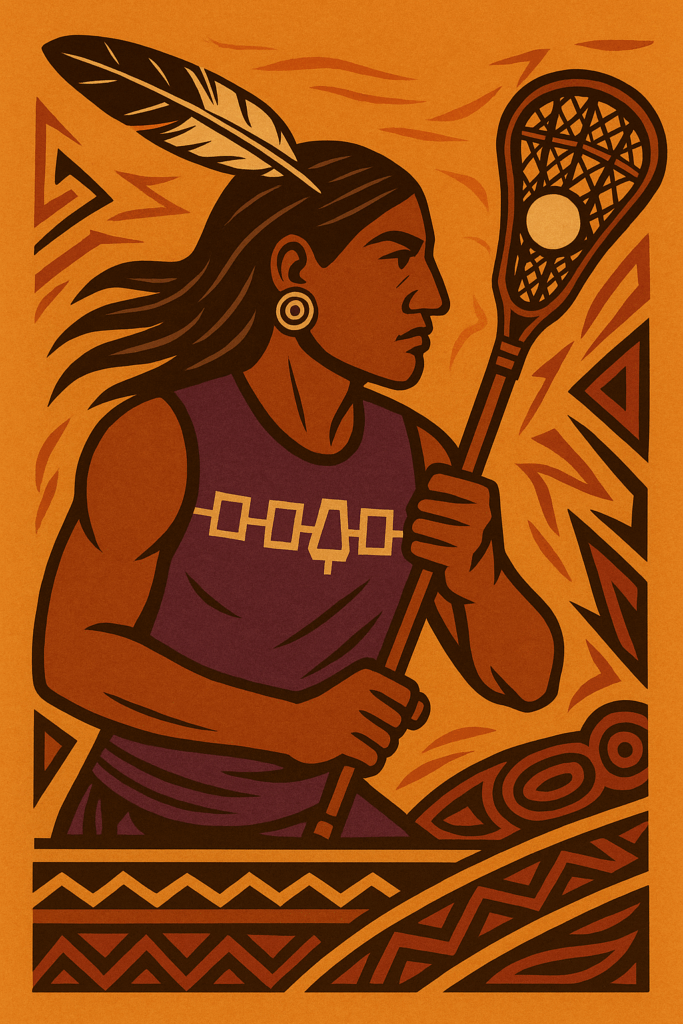
Today—Indigenous Peoples’ Day (Monday, October 13, 2025)—we pause to honor the original peoples of this land and the cultures that continue to shape our communities. For those of us in lacrosse, this day carries particular meaning. The sport we love is an Indigenous game with deep cultural, spiritual, and communal significance that long predates modern rules and leagues. (USA Lacrosse)
“The Creator’s Game”
Among the Haudenosaunee Confederacy (often known as the Iroquois: Mohawk, Oneida, Onondaga, Cayuga, Seneca, and Tuscarora Nations), lacrosse is traditionally called the Creator’s Game. Many Haudenosaunee teachings describe the game as a gift meant to bring people joy, build community, and promote healing—values still echoed any time we pick up a stick. (American Indian Magazine)
A Sport Far Older Than Our Scoreboards
Archaeology and early accounts indicate that Indigenous peoples across North America played stick-and-ball games resembling lacrosse for centuries—some sources place versions of the game as early as the 12th century. These weren’t small matches: games could involve hundreds of players and last for days, serving social, diplomatic, and ceremonial purposes in addition to recreation. (World Lacrosse –)
What Newcomers Should Know
- Origins matter. Modern field and box lacrosse descend from Indigenous games; the version most closely tied to today’s field game comes from Haudenosaunee traditions. (USA Lacrosse)
- It’s more than sport. Historically, lacrosse functioned as ceremony, medicine, and—at times—conflict resolution or training. Referring to it as the Creator’s Game or “medicine game” reflects this broader meaning. (American Indian Magazine)
- Many nations played. While the Haudenosaunee are central to lacrosse’s story, related games were played widely across the Great Lakes, Mid-Atlantic, and the South, with local names and variations. (USA Lacrosse)
Indigenous Excellence on the World Stage
Indigenous athletes continue to lead at the highest levels through the Haudenosaunee Nationals, a sovereign Indigenous organization sanctioned by the Haudenosaunee Grand Council. The program, founded in 1983 and renamed “Haudenosaunee Nationals” in 2022, has earned medals at world championships and competes internationally under the Haudenosaunee flag. (Haudenosaunee)
With lacrosse set to return to the Olympic Games in Los Angeles in 2028, world lacrosse leaders and governments have acknowledged the special place of the Haudenosaunee in the sport’s origins. The United States and Canada issued a joint statement in January 2025 urging a path for Haudenosaunee participation, and discussions have continued among the IOC, World Lacrosse, and national committees. (Status is evolving as eligibility frameworks are finalized.) (The White House)
Respect in Language and Practice
- Use “Indigenous,” “Native,” “First Nations,” or the specific nation (e.g., Haudenosaunee, Onondaga) when known.
- Capitalize nation names and identities, and avoid using past-tense language that implies Indigenous peoples are only historical.
- When hosting events, consider a land acknowledgment developed with local Indigenous partners, and invite Indigenous voices to lead how the game’s history is presented.
Ways to Honor Indigenous Peoples’ Day (and Every Day)
- Learn from authoritative sources
- USA Lacrosse’s histories and heritage resources offer a clear overview for newcomers. (USA Lacrosse)
- The Smithsonian’s National Museum of the American Indian publishes accessible pieces on the Creator’s Game and contemporary issues in international play. (American Indian Magazine)
- World Lacrosse provides background on the sport’s Indigenous origins and global growth. (World Lacrosse –)
- Support Indigenous athletes and programs
- Follow and support the Haudenosaunee Nationals throughout the international season. (Haudenosaunee)
- Carry the values onto your field
- Emphasize community, respect, and joy—the spirit at the heart of the Creator’s Game. Share history with your teams and fans, invite Indigenous speakers when possible, and ensure team imagery and chants avoid stereotypes.
Further Reading
- USA Lacrosse: Lacrosse History and Native American Heritage. (USA Lacrosse)
- Smithsonian NMAI: The Creator’s Game: Native People Created Lacrosse Yet Now Strive to Play the Sport in International Arenas. (American Indian Magazine)
- World Lacrosse: Origin & History. (World Lacrosse –)
- Haudenosaunee Nationals: Organization history and updates. (Haudenosaunee)
- Context on LA28 and inclusion discussions. (The White House)
